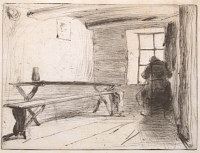Etchings Institutions search term: grolier club
The Miser | ||
| Number: | 17 | |
| Date: | 1858/1859 | |
| Medium: | drypoint | |
| Size: | 120 x 161 mm | |
| Signed: | 'Whistler -' at lower left (7) | |
| Inscribed: | no | |
| Set/Publication: | no | |
| No. of States: | 7 | |
| Known impressions: | 12 | |
| Catalogues: | K.69; M.69; T.62; W.65 | |
| Impressions taken from this plate (12) | ||
TECHNIQUE
The composition was based on a drawing made on the Rhineland trip of 1858; it is not exact in all details, but may well have been traced or copied for the initial draft of the drypoint. For instance the perspective, which is exagerated, is derived from the drawing, but in the drawing there are more objects on the table near the man.
There are numerous states of the drypoint, in which Whistler at first developed the dramatic line and lighting, and then modified the room, adding textures and softening the effect. Many impressions are printed with deep ink tone.
PRINTING
In early proofs the effect of the drypoint burr makes this composition particularly dramatic ( ,
,  ) and in later impressions retroussage was used to maintain this effect (
) and in later impressions retroussage was used to maintain this effect (  ,
,  ). The final state is unusual, with soft textures produced by light, close shading combined with wear, producing almost the appearance of soft ground etching (
). The final state is unusual, with soft textures produced by light, close shading combined with wear, producing almost the appearance of soft ground etching ( ,
,  ).
).
 ,
,  ) and in later impressions retroussage was used to maintain this effect (
) and in later impressions retroussage was used to maintain this effect (  ,
,  ). The final state is unusual, with soft textures produced by light, close shading combined with wear, producing almost the appearance of soft ground etching (
). The final state is unusual, with soft textures produced by light, close shading combined with wear, producing almost the appearance of soft ground etching ( ,
,  ).
).

